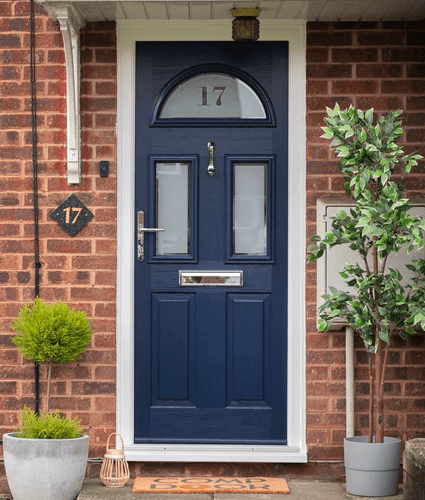
Design Your Door Here
Trickle Vents: What Are They & Do You Need Them?
Trickle Vents Explained
Trickle vents are discreet, built-in openings found in windows that play a crucial role in indoor ventilation. These small heroes contribute to maintaining fresh air within indoor spaces and help prevent problems associated with stale air, enhancing the overall air quality discreetly and effectively.
By enabling a consistent flow of air between the inside and outside, trickle vents are instrumental in eliminating humidity, diminishing indoor pollutants, and assisting in temperature control of a room.
As we delve deeper, you’ll not only discover the essence of what trickle vents are but also understand their significant role in enhancing the comfort and healthiness of your living space.
Window Trickle Vents
Trickle vents are small ventilation devices that are integrated into windows and doors to manage the flow of fresh air into indoor spaces. They enhance indoor air quality by reducing levels of pollutants, moisture, and condensation.
There are several designs of trickle vents to accommodate different types of windows, including through-frame, over-frame, and glazed-in models. These can be installed in new windows or retrofitted into existing frames, which can affect the vent’s performance and effectiveness.
The installation of trickle vents is often regulated by building codes, particularly when older windows are being replaced. The cost of vents averages around £30-50. These regulations ensure that ventilation is maintained to standards promoting health and safety in residential environments.
Trickle Vents Purpose
Trickle vents may not be immediately noticeable on your windows and doors, yet they play a crucial role in the functionality of a window.
These vents are typically incorporated into window frames and serve as essential components of a small ventilation system.
Comprising small openings at the top of windows and doors, trickle vents provide continuous, controlled air circulation within enclosed spaces.
Their main purpose is to allow the natural exchange of fresh air into a room, helping to disperse and dilute indoor pollutants such as volatile organic compounds (VOCs), radon, and excessive moisture.
This significantly enhances the quality of indoor air.
Trickle vents are installed using various methods, with the ‘Up and Over’ design being particularly common.
In this approach, the vent is installed either directly on the window frame or between the glass and the frame, offering a clean look while maintaining effective functionality.
How Do Trickle Vents Work
Trickle vents, or trickle ventilators, are crucial components in building structures. These devices are designed to ensure consistent and fresh air circulation within a room, enhancing the ventilation system.
They play a vital role in maintaining indoor air quality by allowing stale air to escape. However, their benefits extend beyond just air exchange.
Trickle vents help regulate indoor temperatures by enabling a consistent, controlled airflow, which helps keep room temperatures stable while minimizing heat loss.
Functionality of Trickle Vents
Trickle vents operate through a small opening in a window or wall, facilitating a continuous air exchange between the interior and exterior. Here’s how they contribute to a building’s environment:
- Reduce Condensation: They lower the risk of condensation by providing steady air flow, which balances humidity levels inside buildings.
- Enhance Air Quality: By offering a controlled opening in the window frame, they allow fresh air in and stale air out, which refreshes the indoor environment.
- Prevent Mould and Dampness: The airflow limits condensation build-up, reducing mould growth and damp-related issues.
Trickle vents are not only about improving air exchange; they also support a healthier, more comfortable living space by preventing condensation on windows and enhancing the overall indoor climate.
Design and Operation of Trickle Vents
It’s good to know that just as you can customize your doors and windows, you can also tailor the design of your trickle vents to suit your needs.
There are several designs of trickle vents available, each compatible with various types of windows and materials.
Options include through-frame, over-frame, and glazed-in models, all of which can be installed in new windows or retrofitted into existing ones.
The choice of design and the installation method used can greatly influence both the functionality and efficiency of the vents.
Frame Integration of Trickle Vents
Through-frame integration involves installing the trickle vent through the top of the window frame, embedding it seamlessly during the window’s installation.
This method ensures effective ventilation while maintaining the window’s sleek appearance. It also allows the vent to remain discreet yet functional.
Trickle vents can be adapted to various window frame materials, enhancing indoor air quality significantly. Suitable materials include:
- PVC-u
- Timber
- Steel
- Aluminium
These materials are all compatible with the through-frame integration technique, making it a popular option among builders and homeowners alike due to its adaptability and effectiveness.
Over-Frame Additions for Trickle Vents
Trickle Vent Installation on Windows
When a trickle vent cannot be integrated within a window’s frame, over-frame additions provide a viable alternative. This installation method involves placing the vent over the top of the window frame, ensuring it covers either the window’s head or frame to facilitate ventilation.
This method supports consistent airflow, particularly beneficial when standard through-frame trickle vents are not compatible with the existing framework.
Advantages and Considerations
Over-frame additions come with several benefits:
- Enhanced Ventilation: Improves the overall air exchange efficiency.
- Controlled Airflow: Allows for the regulation of air entering and exiting, aiding in environmental consistency.
- Improved Air Quality: Reduces indoor pollutants for a healthier living space.
- Increased Energy Efficiency: Helps maintain temperature control, reducing heating and cooling costs.
However, there are potential drawbacks to consider:
- Security Risks: May weaken the window’s integrity and increase susceptibility to break-ins.
- Heat Loss: Potential for increased heat dissipation, impacting energy consumption.
- Additional Costs: Installation might be more complex and costly.
- Insulation Impact: Could affect the window’s ability to insulate against noise and temperature changes.
When selecting over-frame additions, weighing these pros and cons will help determine the best installation method for enhancing indoor air quality and comfort.
Glazed-In Trickle Vents
Glazed-in trickle vents are designed to integrate seamlessly with the window design, being specifically tailored during the window fabrication process. These vents are fitted along the top of the sealed glass unit, nestled between the glass and the frame profile. To secure the vent, holes are drilled into the window frame.
These vents allow for continuous airflow even when the window is closed, enhancing air quality without sacrificing security. This feature makes glazed-in vents particularly suitable for high-rise buildings, exposed areas, and ground-floor windows, as they form an integral part of the glass structure itself. This integration ensures that the vent does not detract from the window’s aesthetic or structural integrity.
Advantages of Trickle Vents
Let’s explore the benefits that installing trickle vents can bring to your home.
Trickle vents are advantageous not only for their ventilation capabilities. They significantly enhance indoor air quality through what’s known as background ventilation. This continuous air flow helps remove moisture and indoor pollutants, potentially preventing issues like leaky windows.
Here are the key issues that trickle vents help mitigate:
- Moisture Buildup: Reduces excessive moisture within a room.
- Condensation: Lowers the likelihood of condensation on window surfaces.
- Dampness: Prevents the accumulation of damp conditions.
- Mould Growth: Curbs the growth of mould by maintaining drier air.
Additionally, trickle vents help extend the lifespan of windows by providing controlled ventilation, which:
- Enhances Security: Reduces the need to keep windows constantly open, thus improving the home’s security.
- Minimizes Wear and Tear: Helps avoid mechanical wear and tear on window mechanisms.
- Prolongs Window Life: Contributes to the overall longevity of your windows.
Overall, trickle vents offer a practical solution to improve indoor air quality and window durability while ensuring the security and structural integrity of your home.
Installing Trickle Vents
Although the installation process might appear daunting, hiring a professional can alleviate any concerns you might have.
Trickle vents can be installed in new windows or retrofitted into existing ones, requiring precise drilling and secure fastening to ensure proper function.
The specific type of trickle vent and the particular needs of the window or door on which it is being installed are crucial to the installation process. These factors determine the exact method and precision needed for effective installation.
Retrofitting Trickle Vents
While it’s possible to retrofit trickle vents on any window type with sufficient DIY skills, professional installation is generally advised. This approach ensures precise drilling and adherence to complex building regulations, which might be daunting for the average homeowner.
It’s preferable to hire an expert to install trickle vents to sidestep any potential issues.
The steps involved in retrofitting trickle vents into existing windows include:
- Identifying the Optimal Location: Determine the best spot on the window for the vent to ensure maximum efficiency.
- Measuring and Marking: Carefully measure and mark the designated spot on the window frame.
- Drilling Holes: Precisely drill holes at the marked spots.
- Installing the Vents: Secure the vents into the drilled holes.
- Making Adjustments: Fine-tune the installation to guarantee optimal airflow and performance.
This method allows homeowners to enhance their existing windows with trickle vents, improving air quality and moisture control without the need for complete window replacement.
Installing Trickle Vents in New Windows
For new windows, installing trickle vents typically includes the following steps:
- Drilling a Ventilation Hole: Use a specially designed drill bit to create a ventilation hole through the window frame.
- Positioning the Vent: Place the trickle vent on the frame and mark its precise location.
- Securing the Vent: Drill holes as marked to fit and securely install the vent.
- Gathering Tools: Ensure you have the necessary tools for installation. This includes a suitable type of through-frame trickle vent, a pen or pencil for marking, tape, a measuring tape, drill, screwdriver, and silicone sealant.
The time it takes to install a trickle vent in a new window can vary based on the window specifics and the installation method used.
It’s recommended to consult with a professional installer for an accurate time estimate and to ensure the vent is installed correctly for optimal functionality.
Understanding Misconceptions About Trickle Vents
Trickle vents are often misunderstood, with common concerns focusing on their potential effects on energy efficiency and sound insulation. However, these issues can typically be resolved through correct installation and careful selection of the vent type. When installed properly, trickle vents do not significantly impact a building’s thermal or acoustic performance but instead provide essential benefits in air quality and moisture control.
Addressing Energy Efficiency Concerns with Trickle Vents
Energy efficiency concerns are often mistakenly associated with trickle vents. While it’s true that these vents can slightly affect a home’s airtightness, they generally enhance overall energy management rather than detract from it.
Trickle vents promote background ventilation, which is crucial for reducing heat loss and improving energy efficiency in the home.
Benefits of Trickle Vents Include:
- Temperature Regulation: By maintaining a steady and comfortable flow of air, trickle vents help stabilize indoor temperatures.
- Condensation Mitigation: They prevent condensation buildup by enabling continuous air circulation.
- Heat Loss Minimization: Contrary to the common belief that they lead to significant heat loss, trickle vents actually help minimize it by providing background ventilation. This reduces the necessity for extensive mechanical heating or cooling systems.
Overall, when used correctly, trickle vents contribute positively to a building’s energy efficiency, making them a beneficial addition in terms of comfort and cost-effectiveness.
Sound Insulation and Trickle Vents
A prevalent misconception is that trickle vents negatively affect sound insulation. However, the sound insulation capacity of trickle vents can actually be significantly improved with the right techniques.
Enhancements to soundproof trickle vents can include:
- Using Resilient Materials: Trickle vents constructed from sturdy materials such as PVC can naturally improve sound insulation.
- Acoustic Lining: Incorporating acoustic linings and specialized materials within the vent can further enhance soundproofing capabilities.
- Sound Absorption Design: These vents are designed to absorb and dissipate sound energy, effectively reducing noise infiltration.
- Compatibility: Soundproofing features can be integrated with various types of trickle vents.
- Frequency Attenuation: They are capable of attenuating a wide range of noise frequencies, making them effective against diverse environmental noises.
By implementing these enhancements, trickle vents can contribute to a quieter indoor environment without compromising their primary function of air ventilation.
Compliance with Building Regulations for Trickle Vents
Compliance with building regulations is crucial when installing trickle vents.
Under current building codes, it is mandatory to install trickle vents when replacing any window or door that was previously equipped with one.
These regulations are designed to ensure that homes meet the minimum requirements for background ventilation, which can effectively be maintained through the use of trickle vents.
Building Regulations Update for Trickle Vents
As of 15th June 2022, the updated building regulations require the installation of trickle vents on any replacement windows where they were previously in place.
Non-compliance with these regulations can lead to legal consequences, including fines of up to £5,000 for violations.
How Much Are Trickle Vents
Trickle Vents Costs
With all this information, you’re likely interested in the price range for retrofit trickle vents to enhance your home’s ventilation.
The cost of trickle vents can vary depending on factors like type, size, and installation approach. Typically, they can be found between £30 and £50 per vent, offering a range of quality and features within that budget.
For options like through-frame, over-frame, or glazed-in styles, prices usually range from £15 to £25 per window. It’s worth noting that costs may differ between new installations and retrofitting existing windows.
While it may seem like an added cost, the advantages of professional installation—such as adherence to building regulations, precise fitting, and optimized vent performance—often justify the investment.
Our Thoughts on Trickle Ventilators for Your Windows
Now that we’ve delved into the details surrounding trickle vents, we trust you recognize their significant role once they’re installed.
Trickle vents play a crucial role in upholding indoor air quality, managing temperature, and combating condensation in residential and commercial spaces.
Available in various designs, including through-frame, over-frame, and glazed-in options, they seamlessly integrate with different window types and materials.
Contrary to common beliefs, properly chosen and installed trickle vents can actually boost energy efficiency and enhance sound insulation.
Moreover, they are essential for meeting building regulations and can be incorporated into both new constructions and existing windows.
While there may be associated costs with purchasing and installing them, the multitude of benefits they offer—ranging from improved health and comfort to energy savings—make trickle vents a valuable investment.
FAQ's
Can trickle vents help combat condensation?
Absolutely.
Trickle vents play a crucial role in minimizing condensation by ensuring continuous background ventilation, particularly around windows, thereby curbing moisture build-up without compromising on heat retention.
Are trickle vents a worthwhile addition?
Indeed, trickle vents offer significant benefits. They can enhance air quality and mitigate issues like dampness or mould formation, particularly beneficial for those with double-glazed windows or residing in new builds.
Should trickle vents be open or closed during winter?
Trickle vents are best left open in winter to prevent the accumulation of mould and condensation. Keeping them open permits a controlled airflow, contributing to a healthier indoor environment.
Do trickle vents contribute to heat loss?
No, trickle vents are designed to maintain indoor air quality without significant heat loss. They can remain open year-round without causing substantial heat loss.
What's the main purpose of trickle vents?
Trickle vents primarily promote natural air circulation, effectively dispersing indoor pollutants and improving overall indoor air quality.





